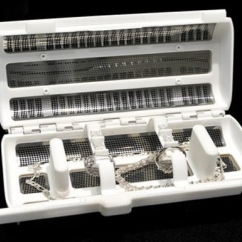Articles and News
Is Your Jewelry Making You Sick? | October 02, 2013 (1 comment)

Manchester, NH—Between hand sanitizer, shopping-cart wipes, and special washes created just for vegetables, Americans really try to avoid getting sick. But hiding in plain sight, most overlook one of the most obvious places that germs and bacteria might be lurking: in the nooks and crannies of the jewelry they wear every day. In fact, jewelry—along with cell phones, computer keyboards, and remote controls—are likely to be the dirtiest items most Americans own.
One jeweler, David Bellman of Bellman Jewelers, has developed a special device that will help solve the problem: an at-home, professional-quality jewelry cleaning system that is designed not only to get the grime off your diamond but also to rid it of bacteria and germs that can lead to the flu or food-borne illnesses.
“Washing your hands does not eliminate bacteria from your jewelry,” says Bellman, president and founder of his eponymous store. “Even if a person washes his or her hands religiously, there can still be millions of bacteria lurking on the surface and festering between the nooks and crannies of a jewelry setting, and that bacteria can make you sick.” In one day of testing with a common portable hygiene tester (the kind hospitals and restaurants use), Bellman found that 90% of women’s rings he tested harbored more bacteria than a public men’s room toilet seat.
Eeeew, gross! Though to put the toilet seat analogy into perspective, the one Bellman tested was at a hotel where, presumably, they're cleaned daily. Most jewelry is not.
Bellman, a jeweler for 32 years, got the idea for a sanitizing system when he realized how rarely most people clean their jewelry. In a video for the AquaSonic Wave device, he recounts his “aha!” moment when he realized that almost all the jewelry customers brought in for repair or appraisal was filthy. He began to wonder what it meant for him and his team to be handling it, so he sent some pieces to a lab to be analyzed for bacteria. The results, he says, were truly horrifying. The jewelry harbored more bacteria than common culprits like vending machine handles, ATM buttons, escalator handles, or gasoline pump handles—in fact, sometimes three times as much.
Enter the AquaSonic Wave, designed to both clean and sterilize jewelry—at home in the dishwasher. The AquaSonic Wave actually is the third generation of a device Bellman invented in 1995 to clean jewelry in the dishwasher. The first two generations aren’t unknown to the jewelry industry—they were sold on HSN and QVC and in some jewelry stores, with moderate success, Bellman told The Centurion. But the third generation AquaSonic has been completely retooled to address the germ and bacteria issue.
To get a medical perspective, Bellman turned to Dean Kamen, who has such notable inventions as a portable kidney dialysis machine and the Segway transport to his credit. Kamen lives in New Hampshire, near Bellman’s Jewelers.
“He’s a local guy and we’ve done some business together, so when I approached him about this, he said he’d be happy to help,” said Bellman. “It’s not like Johnson & Johnson or the other big companies he’s consulted with, but it is a medical issue so he was interested in working on it.”
Using steam, soap, water, and a proprietary anti-bacterial agent within a home dishwasher, the AquaSonic Wave can remove 99% of dirt and germs from the average jewelry surface, say the inventors. It has both design and utility patents pending.
Bellman is trying to gain funding for production through a site called Kickstarter.com, a crowd-funding website designed to help raise money for new inventions that have successfully been prototyped and are ready for production. Bellman has raised $3,540 of the $90,000 he needs for production costs; he’s hoping fellow jewelers will pre-order a device to help raise the necessary funds.
“It’s not like we’re asking, ‘hey, give us money.’ We’re pre-selling the device; the first 50 people who pre-order one get it for $40, and after that, they’ll cost $50.” The $40 ones are almost sold out, he says. “But you own the device for life.”
Why would jewelers want to tell their customers to wash their jewelry with their dirty pots and pans?
“The things you need to clean jewelry are soap, water, and steam. The average home dishwasher has all those elements in it,” says Bellman. With the right kind of device to hold the jewelry securely, it should come out as clean as your dishes, he says. The only difference between it and the professional steam cleaner in his store is the amount of psi—pounds of pressure per square inch. Professional jewelry-cleaning equipment has about 40 psi; a home dishwasher has between 10 and 15 psi. Even better, says Bellman, users can clean their jewelry and their dishes at the same time, saving water. He recommends people use it every two weeks or so.
What about getting the remains of dinner on your diamond?
Not so, says Bellman. “I’ve done it tens of thousands of times [with the previous generations of the device]. I’ve never found a speck of food on any jewelry. And even if you do, it’s still a lot less than the bacteria you’ve gotten off it.”
Most kinds of jewelry are safe to clean with the device. Fragile stones like emeralds, opals, and pearls should continue to be hand-cleaned, he says, and in fact dishwasher detergent is milder than most solvents used to clean jewelry in a jewelry store. And his website urges clients to have their jewelry checked regularly by a jeweler for wear and tear, just as they normally would.
For more information or to pre-order the system, click here.







